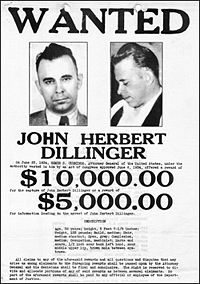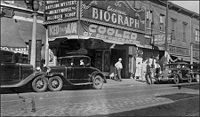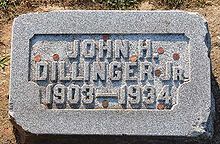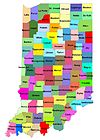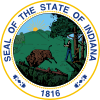- John Dillinger
-
John Dillinger 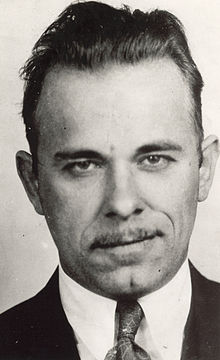

Born John Herbert Dillinger, Jr.
June 22, 1903
Indianapolis, Indiana, U.S.Died July 22, 1934 (aged 31)
Chicago, Illinois, U.S.Charge(s) Bank robbery, murder Penalty Imprisonment from 1924 to 1933 Spouse Beryl Hovious (divorced) John Herbert Dillinger, Jr. (June 22, 1903 – July 22, 1934) was an American bank robber in Depression-era United States. He was charged with, but never convicted of, the murder of an East Chicago, Indiana police officer during a shoot-out. This was his only alleged homicide. His gang robbed two dozen banks and four police stations. Dillinger escaped from jail twice.
In 1933–34, seen in retrospect as the heyday of the Depression-era outlaw, Dillinger was the most notorious of all, standing out even among more violent criminals such as Baby Face Nelson, Pretty Boy Floyd, and Bonnie and Clyde. Media reports were spiced with exaggerated accounts of Dillinger's bravado and daring and his colorful personality. The government demanded federal action, and J. Edgar Hoover developed a more sophisticated Federal Bureau of Investigation as a weapon against organized crime and used Dillinger and his gang as his campaign platform to launch the FBI .[1]
After evading police in four states for almost a year, Dillinger was wounded and returned to his father's home to recover. He returned to Chicago in July 1934 and met his end at the hands of police and federal agents who were informed of his whereabouts by Ana Cumpanas (the owner of the lodge where Dillinger sought refuge at the time). On July 22, the police and Division of Investigation[2][3] closed in on the Biograph Theater. Federal agents, led by Melvin Purvis, moved to arrest him as he left the theater. He pulled a weapon and attempted to flee but was shot three times and killed.
Contents
Early life
Family and background
John Herbert Dillinger, Jr. was born in the Oak Hill section of Indianapolis, Indiana,[4] the younger of two children born to John Wilson Dillinger (July 2, 1864 – November 3, 1943) and Mary Ellen "Mollie" Lancaster (1860–1907).[5]:p10 According to some biographers, his grandfather, Matthias Dillinger, immigrated to the United States in 1851 from Metz, in the region of Alsace-Lorraine, then under French sovereignty.[6] Matthias Dillinger was born in German-Prussian Gisingen, near Dillingen, Saarland. Dillinger's parents had married on August 23, 1887. Dillinger's father was a grocer by trade and, reportedly, a harsh man.[5]:p9 In an interview with reporters, he said that he was firm in his discipline and believed in the adage "spare the rod and spoil the child".[5]:p12 Dillinger's older sister, Audrey, was born March 6, 1889. Dillinger's mother died in 1907 just before his fourth birthday.[5][7] Audrey married Emmett "Fred" Hancock in 1907, had seven children and resided in Maywood, Indiana. She died in Indianapolis in March 1987 at the age of 98 years. Dillinger was cared for by his sister during his early life until his father remarried on May 23, 1912, to Elizabeth "Lizzie" Fields (1878–1933). Initially, Dillinger disliked his stepmother but reportedly eventually came to love her.[8] Dillinger's father and stepmother had three children, Hubert Dillinger, born c. 1913, Doris M. Dillinger (December 12, 1917 – March 14, 2001) and Frances Dillinger (born c. 1922).[7][9]
Formative years and marriage
As a teenager, Dillinger was frequently in trouble with the law for fighting and petty theft; he was also noted for his "bewildering personality" and bullying of smaller children.[5]:p14 He quit school to work in an Indianapolis machine shop. Although he worked hard at his job, he would stay out all night at parties. His father feared that the city was corrupting his son, prompting him to move the family to Mooresville, Indiana, in about 1920.[5]:p15 Dillinger's wild and rebellious behavior was resilient despite his new rural life. He was arrested in 1922 for auto theft, and his relationship with his father deteriorated.[5]:pp16-17 His troubles led him to enlist in the United States Navy where he was a Fireman 3rd Class assigned aboard the battleship USS Utah,[10] but he deserted a few months later when his ship was docked in Boston. He was eventually dishonorably discharged.[5]:pp18-20 Dillinger then returned to Mooresville where he met Beryl Ethel Hovious.[11] The two were married on April 12, 1924. He attempted to settle down, but he had difficulty holding a job and preserving his marriage.[5]:p20 The marriage ended in divorce on June 20, 1929.[7][12]
Dillinger was unable to find a job and began planning a robbery with his friend Ed Singleton.[5]:p22 The two robbed a local grocery store, stealing $50.[5]:p26 Leaving the scene they were spotted by a minister who recognized the men and reported them to the police. The two men were arrested the next day. Singleton pleaded not guilty, but Dillinger's father convinced him to confess to the crime and plead guilty.[5]:p24 Dillinger was convicted of assault and battery with intent to rob, and conspiracy to commit a felony. He was sentenced to 10 to 20 years in prison for his crimes.[7] His father told reporters he regretted his advice and was appalled by the sentence. He pleaded with the judge to shorten the sentence but with no success.[5]:p25 En route to the prison, Dillinger briefly escaped his captors but was apprehended within a few minutes.[5]:p27
Criminal career
Prison time
Dillinger embraced the criminal lifestyle behind bars in the Indiana State Prison in Michigan City. Upon being admitted to the prison he is quoted as saying, "I will be the meanest bastard you ever saw when I get out of here."[5]:p26 His physical examination upon being admitted to the prison showed that he had gonorrhea. The treatment for his condition was extremely painful.[5]:p22 He became embittered against society because of his long prison sentence and befriended other criminals, such as seasoned bank robbers like Harry Pierpont and Russell Clark, who taught Dillinger how to be a successful criminal. The men planned heists that they would commit soon after they were released.[5]:p32 John Dillinger studied Herman Lamm's meticulous bank-robbing system and used it extensively throughout his criminal career.
His father launched a campaign to have him released and was able to get 188 signatures on a petition. Dillinger was paroled on May 10, 1933, after serving four and a half years. Dillinger's stepmother became sick just before he was released from prison, and she died before he arrived at her home.[5]:p37 Released at the height of the Great Depression, Dillinger had little prospect of finding employment.[5]:p35 He immediately returned to crime[5]:p39 and on August 14 robbed a bank in Bluffton, Ohio. Tracked by police from Dayton, Ohio, he was captured and later transferred to the Allen County jail in Lima to be indicted in connection to the Bluffton robbery. After searching him before letting him into the prison, the police discovered a document which appeared to be a prison escape plan. They demanded Dillinger tell them what the document meant, but he refused.[7]
Dillinger had helped conceive a plan for the escape of Pierpont, Clark and six others he had met while previously in prison, most of whom worked in the prison laundry. Dillinger had friends smuggle rifles into their prison cells which they used to escape, killing two guards, four days after Dillinger's capture. The group known as "The First Dillinger Gang" included Harry "Pete" Pierpont, Russell Clark, Charles Makley, Edward W. Shouse, Jr., Harry Copeland, James "Oklahoma Jack" Clark, John "Red" Hamilton and Dillinger's mentor Walter Dietrich, a member of the Herman Lamm Gang. Three of the escapees arrived in Lima on October 12, where they impersonated Indiana State Police officers, claiming they had come to extradite Dillinger to Indiana. When sheriff Sarber asked for their credentials, they shot him and beat him unconscious, then released Dillinger from his cell. The four men escaped back into Indiana where they joined the rest of the gang.[7] Sheriff Sarber was the gang's first police killing of an estimated 13 lawmen deaths by Dillinger gang members.[13]
Bank robberies
The Bureau of Investigation (BOI), a precursor of the Federal Bureau of Investigation,[2] was brought into the investigation to help identify the criminals, although the men had not violated any federal law. It was one of the first cases in which the BOI intervened in matters outside its jurisdiction. Using their superior fingerprint matching technology, they successfully identified all of the suspects and issued national bulletins offering rewards for their capture.[7]
Dillinger and his gang began a streak of bank robberies across Indiana. Among Dillinger's more celebrated exploits was his pretending to be a sales representative for a company that sold bank alarm systems. He reportedly entered a number of Indiana and Ohio banks and used this ruse to assess security systems and bank vaults of prospective targets. Another time, the gang pretended to be part of a film company that was scouting locations for a "bank robbery" scene. Bystanders stood and smiled as a real robbery ensued and Dillinger and friends escaped with the loot. Stories such as this only served to increase Dillinger's burgeoning legend. Dillinger was believed to have been associated with gangs who robbed dozens of banks and accumulated a total of more than $300,000. Banks allegedly robbed by Dillinger and his associates include the Commercial Bank, Daleville, Indiana of $3,500 on July 17, 1933; Montpelier National Bank, Montpelier, Indiana of $6,700 on August 4, 1933; Bluffton Bank, Bluffton, Ohio, of $6,000 on August 14, 1933; Massachusetts Avenue State Bank, Indianapolis, Indiana, of $21,000 on September 6, 1933; Central National Bank And Trust Co., Greencastle, Indiana, of $74,000 on October 23, 1933; American Bank And Trust Co., Racine, Wisconsin, of $28,000 on November 20, 1933; Unity Trust And Savings Bank, Chicago, Illinois, of $8,700 on December 13, 1933; First National Bank, East Chicago, Indiana, of $20,000 on January 15, 1934; Securities National Bank And Trust Co., Sioux Falls, South Dakota, of $49,500 on March 6, 1934; First National Bank, Mason City, Iowa, of $52,000 on March 13, 1934; First National Bank, Fostoria, Ohio of $17,000 on May 4, 1934; and Merchants National Bank, South Bend, Indiana, of $29,890 on June 30, 1934.[7] One possibly true urban legend is that he robbed 1,000 coin bags of Peace Dollars.
On December 11, 1933, a member of the Dillinger gang killed San Antonio Detective Henry C. Perrow.[14] To obtain more supplies, the gang attacked the state police arsenals in Auburn and Peru, stealing machine guns, rifles, revolvers, ammunition and bulletproof vests.[7] They then headed to Chicago to hide out. On December 14, 1933, gang member John "Red" Hamilton murdered a police detective.[15] A month later, Dillinger led the gang in another bank robbery, holding up the First National Bank in East Chicago and killing police officer William O'Malley. Dillinger was officially charged with the murder although the identity of the actual killer was debatable, and it is in question whether Dillinger participated in the robbery at all.[16]:p154 As police began closing in again, the men left Chicago to hide out first in Florida; later at the Gardner Hotel in El Paso, Texas, where a highly visible police presence dissuaded Dillinger from trying to cross the border at the Santa Fe Bridge in downtown El Paso to Ciudad Juárez, Mexico; and finally in Tucson, Arizona.[7]
On the run
A fire broke out at the Hotel Congress in Tucson where members of the Dillinger gang were staying. Forced to leave their luggage behind, they were rescued through a window and down a fire truck ladder. Charles Makley tipped a couple of firemen $12 to climb back up and retrieve the luggage, affording the firefighters a good look at several members of Dillinger's gang. The firemen later recognized Makley and Ed Shouse while thumbing through a copy of True Detective and informed the police who promptly arrested Harry Pierpont, Charles Makley, Russell Clark, Ed Shouse and Dillinger.[17] They found them in possession of over $25,000 in cash and several automatic weapons. Tucson celebrates the historic arrest with an annual "Dillinger Days" festival, the highlight of which is a reenactment.[18]
The men were extradited to Indiana, where Dillinger was held in the Lake County Jail in Crown Point, while the others were then sent to Ohio to stand trial for the murder of Sheriff Jess Sarber. Testimony by Shouse identified the five men as members of the Pierpont gang.[citation needed] Dillinger was charged with the murder of a police officer in East Chicago, while Pierpont and Makley were charged with the murder of Sheriff Jesse Sarber.[citation needed] The police boasted to area newspapers that the jail was escape-proof and posted extra guards to make sure. Louis Piquett, John Dillinger's attorney, was able to sneak a wooden gun within the prison and into the hands of Dillinger. Using it, he was able to trick a guard into opening his cell. He then took two men hostage, rounded up all the guards in the jail, locked them in his cell, and fled. Before leaving, Dillinger said to the guards he locked up, "See what I locked all of you monkeys up with? Nothing but a little piece of wood. Well, so long, boys. I'll have to be moving on."[19] Dillinger stole Sheriff Lillian Holley's new Ford car, embarrassing her and the town, and traveled to Chicago.[19] In so doing, he crossed the state line in a stolen car, breaking the federal Motor Vehicle Theft Act. The crime was under the jurisdiction of the Bureau of Investigation who immediately took over the Dillinger case after the car was found abandoned in Chicago. Dillinger was indicted by a local grand jury, and the BOI organized a nationwide manhunt for him.[20] On June 10, 1933, the infamous John Dillinger committed his first bank robbery, taking $10,000 from the New Carlisle National Bank, which occupied the building which still stands at the southeast corner of Main Street and Jefferson Street (state routes 235 and 571) in New Carlisle, Ohio.
In October 1933 in Chicago, Dillinger began living with his girlfriend Evelyn "Billie" Frechette. They proceeded to Saint Paul, Minnesota, met up with "Red" Hamilton, and mustered a new gang, adding Lester "Baby Face Nelson" Gillis, Homer Van Meter, Tommy Carroll, Joseph Fox, Joe Burns, James Jenkins, John Paul Chase, Charles Fisher, and Eddie Green. The landlord of their apartment became suspicious and on March 30, 1934, reported his suspicions to a federal agent. The building was placed under surveillance by the federal agents who soon determined Dillinger was in the apartment.[7] When one gang member was questioned, he opened fire on the agents before escaping behind a closed door. The entire gang then opened fire on the agents and fled out of a back entrance before back-up could arrive. They commandeered a truck and drove to Eddie Green's home. Dillinger was wounded in the escape and required medical attention. Federal agents later closed in on the building, and the gang opened fire as they escaped and split up. Eddie Green was killed in the escape. Dillinger and his girlfriend traveled to the home of Dillinger's father in Mooresville, where they remained until the wound healed. When Frechette returned to Chicago to visit a friend, she was arrested but refused to reveal Dillinger's whereabouts.
Dillinger returned to crime again. He and Homer Van Meter robbed the police station in Warsaw, Indiana, stealing guns and bulletproof vests. After separating, Dillinger picked up Hamilton, who was recovering from a wound sustained in a heist in Mason City, Iowa. The two then traveled to the Upper Peninsula of Michigan, where they remained for a short time. Dillinger received a tip that federal agents were headed there and left just days before they arrived.[7]
Final months
Little Bohemia Lodge
In April, the Dillinger gang settled at a lodge hideout called Little Bohemia Lodge, owned by Emil Wanatka, in the northern Wisconsin town of Manitowish Waters. The gang assured the owners that they would give no trouble, but they monitored the owners whenever they left or spoke on the phone. Emil's wife Nan and her brother managed to evade Baby Face Nelson, who was tailing them, and mailed a letter of warning to a U.S. Attorney's office in Chicago, which later contacted the Division of Investigation. Days later, a score of federal agents led by Hugh Clegg and Melvin Purvis approached the lodge in the early morning hours. Two barking watchdogs announced their arrival, but the gang was so used to Nan Wanatka's dogs that they did not bother to inspect the disturbance. It was only after the federal agents mistakenly shot a local resident and two innocent Civilian Conservation Corps workers as they were about to drive away in a car that the Dillinger gang was alerted to the presence of the BOI.[21] Gunfire between the groups lasted only momentarily, but the whole gang managed to escape in various ways despite the agents' efforts to surround and storm the lodge. Agent W. Carter Baum was shot dead by "Baby Face" Nelson during the gun battle.[7][22]
The next day, Dillinger, Van Meter and Hamilton were confronted by authorities in Hastings, Minnesota. Hamilton was mortally wounded in the encounter. He was taken by Dillinger and Van Meter to see Joseph Moran, though Moran refused to treat Hamilton. He died in Aurora, Illinois on April 30, 1934. Dillinger, Van Meter and members of the Barker-Karpis gang buried him. Dillinger and Van Meter then met up with Carroll, and the three spent all of May in hiding. On June 7, the three had a shootout with authorities, and Carroll died in the encounter. Dillinger and Van Meter reunited with Nelson a week later and went into hiding.
By July 1934, Dillinger had dropped completely out of sight, and the federal agents had no solid leads to follow. He had, in fact, drifted into Chicago and went under the alias of Jimmy Lawrence, a petty criminal from Wisconsin who bore a close resemblance to the bank robber. Taking up a job as a clerk, Dillinger found that, in a large metropolis like Chicago, he was able to lead an anonymous existence for a while. What Dillinger did not realize was that the center of the federal agents' dragnet happened to be in Chicago. When the authorities found Dillinger's bloodied getaway car on a Chicago side street, they were positive that he was in the city.[7]
Cubs Games
Dillinger had always been a fan of the Chicago Cubs, and instead of lying low like many criminals on the run, he continued to attend Cubs games at Wrigley Field during the months of June and July 1934.[23]
Woman in red
Division of Investigations chief J. Edgar Hoover created a special task force headquartered in Chicago to locate Dillinger. On July 21 a madam from a brothel in Gary, Indiana, Ana Cumpănaş, also known as Anna Sage, contacted the police. She was a Romanian immigrant threatened with deportation for "low moral character"[24] and offered the federal agency information on Dillinger in exchange for their help in preventing her deportation. The agency agreed to her terms. Cumpănaş told them that Dillinger was spending his time with another prostitute, Polly Hamilton, and that she and the couple would be going to see a movie together on the following day. She agreed to wear an orange dress, which is believed to have appeared red in the artificial lights of the theater,[25] so that police could easily identify her. She was unsure which of two theaters they would be attending but told the agency their names: the Biograph and the Marbro.[7]
A team of federal agents and officers from police forces outside Chicago was formed, along with a very few Chicago police officers. Among them was Sergeant Martin Zarkovich, to whom Sage had informed of Dillinger. Federal officials felt that the Chicago police had been compromised and could not be trusted, and Hoover and Purvis also wanted a Federal coup for their own reasons.[25] Not chancing another embarrassing escape, the police were split into two teams. On July 22, one team was sent to the Marbro Theater on the city's west side, while another team surrounded the Biograph Theater at 2433 N. Lincoln Avenue on the north side. During the stakeout, the Biograph's manager thought the agents were criminals setting up a robbery. He called the Chicago police who dutifully responded and had to be waved off by the federal agents, who told them that they were on a stakeout for an important target.[7]
Biograph Theater and death
Dillinger attended the film Manhattan Melodrama[26] at the Biograph Theater in Chicago's Lincoln Park neighborhood. Dillinger was with Polly Hamilton and Ana Cumpănaş. Once they determined that Dillinger was in the theater, the lead agent (Samuel P. Cowley) contacted J. Edgar Hoover for instructions, who recommended that they wait outside rather than risk a gun battle in a crowded theater. He also told the agents not to put themselves in harm's way and that any man could open fire on Dillinger at the first sign of resistance. When the movie let out, Special Agent Melvin Purvis[27] stood by the front door and signaled Dillinger's exit by lighting a cigar. Both he and the other agents reported that Dillinger turned his head and looked directly at the agent as he walked by, glanced across the street, then moved ahead of his female companions, reached into his pocket but failed to extract his gun,[5]:p353 and ran into a nearby alley.[25] Other accounts state Dillinger ignored a command to surrender, whipped out his gun, then headed for the alley. Agents already had the alley closed off, but Dillinger was determined to shoot it out.[28]
Agents Cowley, Charles Winstead, and Herman "Ed" Hollis opened fire, firing five shots. Dillinger was hit from behind and he fell face first to the ground.[29] Two female bystanders took slight flesh wounds in the legs and buttocks by flying bullet and brick fragments.[25] Dillinger was struck three times, with two bullets entering the chest, one actually nicking his heart, and the fatal shot, which entered the back of his neck and exited just under his right eye. Although three agents shot Dillinger, Winstead was believed to be the man who fired the fatal shot, and he received a personal letter of commendation from Director Hoover.[25] An ambulance was summoned, though it was clear that Dillinger had quickly died from his gunshot wounds. At 10:50 p.m. on July 22, 1934, John Dillinger was pronounced dead at Alexian Brothers Hospital.[7][29] According to the investigators, Dillinger died without saying a word.[30] There were also reports of people dipping their handkerchiefs and skirts into the pools of blood that had formed as Dillinger lay in the alley in order to secure keepsakes of the entire affair.[31][dead link] Dillinger's body was displayed to the public at the Cook County morgue after his death.[32]
Dillinger was buried at Crown Hill Cemetery (Section: 44, Lot: 94) in Indianapolis.[33] His gravestone has had to be replaced several times because of vandalism by people chipping off pieces as souvenirs.[34]
Film depictions
- 1945: Lawrence Tierney played the title role in the first film dramatization of Dillinger's career; Dillinger.
- 1957: Director Don Siegel's film Baby Face Nelson, starred Mickey Rooney as Nelson and Leo Gordon as Dillinger.
- 1959: The FBI Story starring James Stewart, Jean Willes plays Anna Sage and Scott Peters plays Dillinger. Peters, a small-time actor, went uncredited in this role.
- 1969: Director Marco Ferreri's film Dillinger Is Dead includes documentary footage of real John Dillinger as well as newspaper clips.
- 1973: Dillinger, directed and written by John Milius with Warren Oates in the title role, presents the gang in a much more sympathetic light, in keeping with the anti-hero theme popular in films after Bonnie and Clyde (1967).
- 1979: Lewis Teague directed the film The Lady in Red, starring Pamela Sue Martin as the eponymous lady in the red dress. However, in this film, it is Dillinger's girlfriend Polly in red, not the Romanian informant Anna Sage (Louise Fletcher). Sage tricks Polly into wearing red so that FBI agents can identify Dillinger (Robert Conrad) as he emerges from the cinema.
- 1991: A TV film Dillinger, starring Mark Harmon
- 1995: Roger Corman produced the film Dillinger and Capone, featuring Martin Sheen as Dillinger and F. Murray Abraham as Al Capone. Dillinger survives the theater stakeout when the FBI mistakenly gun down his brother and is then blackmailed by Capone into retrieving $15 million from his secret vault.
- 2009: Director Michael Mann's film Public Enemies is an adaptation of Bryan Burrough's book Public Enemies: America's Greatest Crime Wave and the Birth of the FBI, 1933-34.[35] The film features Johnny Depp as John Dillinger and Christian Bale as FBI agent Melvin Purvis, but is inaccurate in some major historical details, such as the timeline of deaths of key criminal figures including Pretty Boy Floyd and Baby Face Nelson.[36]
See also
- The Terror Gang
- List of Depression-era outlaws
- Kenneth "Speedy" Raulerson
References
- ^ Elliott J. Gorn, Dillinger's Wild Ride: The Year That Made America's Public Enemy Number One (2009)
- ^ a b "A Byte Out of History - How The FBI Got Its Name". Federal Bureau of Investigation. March 24, 2006. http://www.fbi.gov/news/stories/2006/march/fbiname_022406. Retrieved 2011-02-17.
- ^ As detailed in the previous citation, the former US Bureau of Investigation lapsed and was termed the Division in 1933. Later, in the 1935 Department of Justice appropriation, Congress officially recognized the Division as the Federal Bureau of Investigation, the FBI. The name became effective on March 22, 1935, when the President signed the appropriation bill.
- ^ Famous Cases & Criminals - John Dillinger
- ^ a b c d e f g h i j k l m n o p q r s t u Matera, Dary (2005). John Dillinger: The Life and Death of America's First Celebrity Criminal. Carroll & Graf Publishers. ISBN 0786715588.
- ^ Was John Dillinger German?, citing The Untold Story by G. Russell Giradin and William J. Helmer; and Dary Matera’s John Dillinger
- ^ a b c d e f g h i j k l m n o p q "Famous Cases: John Dillinger". Federal Bureau of Investigation. http://www.fbi.gov/libref/historic/famcases/dillinger/dillinger.htm. Retrieved 2009-06-26.
- ^ Dillinger: the untold story By G. Russell Girardin, William J. Helmer, Rick Mattix, pp. 11, 21.
- ^ Doris's married surname was Hockman. Frances's married name was Thompson.
- ^ http://militarytimes.com/blogs/scoopdeck/2009/07/06/fireman-3rd-class-john-dillinger/
- ^ "Certificate of Birth: Beryl Hovious." Morgan County Health Department, Martinsville, Indiana. Filed 9-1923.
- ^ Stewart, Tony. Dillinger, The Hidden Truth: A Tribute to Gangsters and G-Men of The Great Depression Era. Xlibris Corporation, 2002. ISBN 1401053734.
- ^ ODMP memorial Sherriff J. Sarber
- ^ ODMP Memorial for Det. H. Perrow
- ^ ODMP memorial Sgt William Shanley
- ^ Nash, Jay Robert (1973). Bloodletters And Bad Men Book 2. Warner Book. ISBN 0446301515.
- ^ Webb, Janet. "The day Tucson corralled Dillinger" Arizona Highways. January 8, 2006.
- ^ Mori, Brian. "Dillinger Days frenzy coming up" Tucson Citizen. January 21, 2009.
- ^ a b DeBartolo, Anthony. "Dillinger's Dupes: Town Seeks to Preserve a Jail Yet Escape a Dastardly Deed." Chicago Tribune. November 4, 1988.
- ^ "FBI History - Famous Cases, John Dillinger". FBI. http://www.fbi.gov/about-us/history/famous-cases/john-dillinger. Retrieved 2011-09-08.
- ^ Toland, John. The Dillinger Days. Da Capo Press, 1995. ISBN 0306806266.
- ^ "Special Agent W. Carter Baum." Officer Down Memorial Page. odmp.org.
- ^ [1]
- ^ Purvis, Alston W.; Alex Tresinowski (2005). The Vendetta. PublicAffairs. pp. 155–156. http://books.google.com/books?id=ubCgZFj6YsgC&pg=PA155&lpg=PA155&dq=vendetta%2Bpurvis%2Bana+sage%2Bprostitute&source=bl&ots=GCveBIdSFz&sig=UOSTMiLeYKUfcW0AtkOyg9pF8PM&hl=en&ei=o4diSrWHGN2_tgfVpb3vDw&sa=X&oi=book_result&ct=result&resnum=1.
- ^ a b c d e Massad Ayoob (July-August 2008), "The death of John Dillinger", American Handgunner, http://findarticles.com/p/articles/mi_m0BTT/is_194_32/ai_n25469377/
- ^ "FBI Headline Archives, John Dillinger". FBI. http://www.fbi.gov/page2/july04/dillinger072304.htm. Retrieved 2009-07-18.
- ^ "FBI History - Famous Cases, John Dillinger". FBI. http://www.fbi.gov/libref/historic/famcases/dillinger/dillinger.htm. Retrieved 2009-07-18.
- ^ The Story of the FBI, E.P. Dutton and Co., Inc. New York, Copyright 1947, p. 195
- ^ a b "Dillinger Slain in Chicago; Shot Dead by Federal Men in Front of Movie Theatre." The New York Times. July 22, 1934.
- ^ May, Allan, and Marilyn Bardsley. "Biograph Encounter." John Dillinger: Bank Robber or Robin Hood? - Crime Library. trutv.com.
- ^ John Dillinger: Hero for the angry masses.
- ^ Lost Indiana: In Grave Condition.
- ^ "Notable Persons." Crown Hill Cemetery and Funeral Home. Accessed July 6, 2009.
- ^ "Dillinger's grave attracting crowds due to "Public Enemies" movie." WKOW-TV. June 29, 2009. Accessed July 6, 2009.
- ^ Costello, Mark. "Public Enemies Review." The New York Times Book Review. August 1, 2004. Retrieved 2-7-09.
- ^ The Real John Dillinger: Is Public Enemies historically accurate?
Further reading
- Beverly, William. On the Lam: Narratives of Flight in J. Edgar Hoover's America. Jackson, Mississippi: University Press of Mississippi. 2003. ISBN 1578065372.
- Burrough, Bryan. Public Enemies: America's Greatest Crime Wave and the Birth of the FBI, 1933-34. New York: Penguin Press. 2004. ISBN 1594200211.
- DeBartolo, Anthony. Dillinger's Dupes: Town Seeks To Preserve A Jail Yet Escape A Dastardly Deed. Chicago Tribune.
- Erickson, Matt and Bill Thornbro. John Dillinger: A Year in the Life. The Times of Northwest Indiana.
- Helmer, William J.; Mattix, Rick (1998). Public Enemies: America's Criminal Past, 1919-1940. New York City, New York: Facts on File. p. 17. ISBN 0816031606.
- Stewart, Tony. Dillinger, The Hidden Truth: A Tribute to Gangsters and G-Men of the Great Depression Era. Xlibris Corporation, 2002. ISBN 1401053734.
- Peters, Robert. What Dillinger Meant to Me Seahorse Press 1983 (with link to complete text online)
- Toland, John. The Dillinger Days. Random House 1963
External links
- Famous Cases: John Dillinger – at the FBI
- Wanted poster: John Dillinger, published 12 March 1934 by U.S. Department of Justice, Division of Investigation
- John Dillinger at Find a Grave
- Dillinger: The Untold Story, Anniversary Edition. Indiana University Press.
- Matera, Dary. Review of John Dillinger. Letters on Pages.
- John Dillinger Historical Crime Museum.
- Dillinger with rare photos from the FBI and U.S. National Archives
- Dillinger not killed
- Johndillinger.com
- View footage of the hunt for Dillinger and Dillinger posing for cameras in 1934
Categories:- American bank robbers
- American outlaws
- American people of German descent
- American mobsters of German descent
- People from Indianapolis, Indiana
- People from Chicago, Illinois
- Crime in Indiana
- Depression-era gangsters
- Burials at Crown Hill Cemetery
- Deaths by firearm in Illinois
- People shot dead by law enforcement officers in the United States
- 1903 births
- 1934 deaths
Wikimedia Foundation. 2010.

